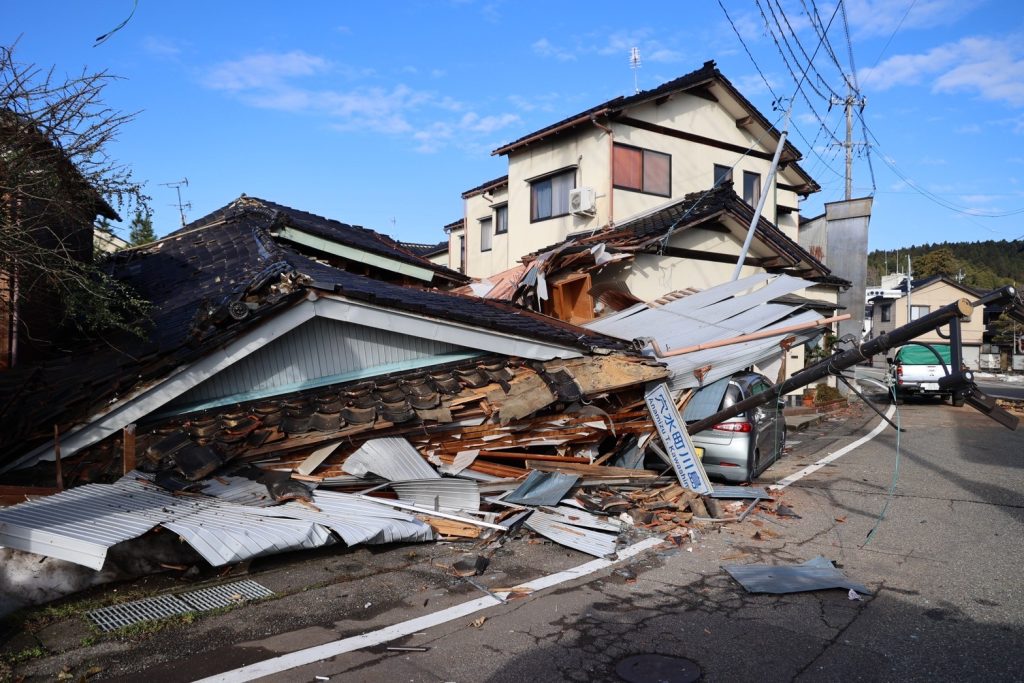Ishikawa Earthquake Week 1: Medical Care and Search-and-Rescue Support

The 7.6 magnitude earthquake that struck the Noto Peninsula in Japan’s western Ishikawa Prefecture on New Year’s Day is the deadliest since the 2011 Great East Japan Earthquake. As of January 5, nearly 100 people were confirmed dead, and more than 200 are still missing beneath the rubble. Tens of thousands of citizens have been forced to evacuate their homes. The situation remains volatile; running water, electricity, and communications, including cell and internet service, are unavailable in many areas. Overall, the true extent of damage remains challenging to assess.
Update from January 5, 2024
Peace Winds is grateful to announce that we have received a $100,000 aid package from USAID. This funding presents the incredible opportunity for our teams on the ground in Ishikawa Prefecture to provide even more lifesaving supplies and medical care to earthquake survivors in need. Learn more about this grant from the U.S. Embassy & Consultants in Japan.
Today, Peace Winds’ own emergency response ship arrived in Suzu Port, delivering much-needed essential items including food, hygiene items, and baby supplies. Going forward, we will continue to use this ship to deliver supplies as well as relief workers from other organizations. Passengers and relief items will travel from a distribution point at Nanao Port on the base of the Noto Peninsula to Suzu’s Iida Port.
The issue of water scarcity and contamination continues to create challenges for survivors and relief workers. This not only includes water for drinking but for bathing and using toilets. To mitigate this problem, Peace Winds has brought water purification machines to the disaster sites and is distributing safe water for evacuations centers.


Update from January 4, 2024
As of January 4, 23 members of Peace Winds’ airborne search-and-rescue team, ARROWS, are on the ground aiding survivors with the help of helicopters and search-and-rescue dogs. The emergency response team is currently based in Suzu City where 7,400 people out of a population of 14,000 are living in evacuation centers. Others are sleeping in cars, greenhouses, and other temporary places.
More than 72 hours have passed since the earthquake struck, unfortunately marking a grim milestone for search-and-rescue efforts. The probability of survival drops dramatically after this point. As the situation progresses, ARROWS’ focus is turning to medical care and operational support at evacuation centers in and around Suzu City. ARROWS teams are working to airlift patients via helicopter, make house calls for elderly and disabled residents, operate a temporary clinic, and perform health checks for survivors living in evacuation centers.
In addition to losing homes, losing loved ones, and facing injuries, Japan’s earthquake survivors are challenged with worsening sanitary conditions. Peace Winds is working to deliver emergency supplies to Suzu City, including food, masks, hygiene items, and baby items. Large trucks are unable to reach the area due to damaged roads, so Peace Winds has sent supplies via ship which will arrive in Suzu Port.

Update from January 3, 2024
Search-and-rescue crews, doctors, nurses, and other ARROWS staff members remain on the ground in Ishikawa Prefecture. Search-and-rescue operations continued today with crews working to locate survivors beneath the rubble. Meanwhile, ARROWS team members are working to support operations and medical aid at local evacuation centers.


Update from January 2, 2024
As of January 2, Peace Winds had a 19-member airborne search-and-rescue team, ARROWS, on the ground, taking part in search and rescue operations and providing medical care and other support in the hardest hit communities.

Late at night on January 1, an advance team from ARROWS arrived in the disaster area to begin assessing the damage and providing survivors with medical and search-and-rescue support. The team was joined by additional staff with two helicopters on January 2, in addition to two rescue dogs.
The ARROWS emergency support team is operating in Suzu City and surrounding areas. Team members and rescue dogs are assisting with search-and rescue operations in hopes of finding survivors beneath the rubble. To provide additional support, Peace Winds/ARROWS doctors and nurses will be working in cooperation with Suzu City General Hospital to provide health screenings and emergency medical care at surrounding evacuation centers.
Approximately 700 people have evacuated to one local high school which is now being used as a temporary shelter. Some people brought their pets with them, and the building is crowded, with many evacuees sleeping at desks in the classrooms. A temporary clinic has also been set up in the nearby middle school, and ARROWS doctors and nurses have spoken to evacuees who are worried because they left their medications behind or are concerned about their pets.

Meanwhile, as the search-and-rescue team continued their work today, they heard a woman calling for help from beneath the rubble. ARROWS workers safely pulled her from the second story of the collapsed home and transported her to the hospital.

As ARROWS, the local government, and other rescue workers determine the needs of survivors, their work will expand. However, the situation remains difficult to assess in many areas. In addition to damaged and destroyed buildings, many residents are facing water and power outages, and Suzu City’s stockpile of supplies is running low. ARROWS team members will remain on the ground providing both short- and long-term support.
New donations to Peace Winds’ “Japan Disaster: Relief and Recovery” project will go toward relief and recovery activities in Ishikawa Prefecture as well as broader disaster preparedness efforts. We will continue to bring updates as we are able, and we thank you for your continued support which makes our work possible.
To support Peace Winds’ emergency response:
From outside of Japan:
From inside Japan: Contribute through Yahoo Fundraising (Japanese only)
For more information on the Peace Winds response and corporate/foundation contributions, please contact us at info@peacewindsamerica.org


